Macroeconomics Report: Italy's Economic Performance Analysis 2005-2017
VerifiedAdded on 2023/03/17
|21
|4325
|89
Report
AI Summary
This report provides a detailed analysis of Italy's macroeconomic performance from 2005 to 2017, examining key economic indicators such as real GDP growth, public debt as a percentage of GDP, inflation rates, interest rates, current account balances, exchange rate trends, and unemployment rates. The analysis covers the impact of the 2007-2008 Global Financial Crisis on the Italian economy, assessing changes in these indicators over time. The report also evaluates the economic policies implemented by the Italian government during this period, offering insights into their effectiveness and the overall economic stability of the country. Furthermore, the report assesses the current economic performance indicators and provides a comprehensive understanding of Italy's economic landscape during the analyzed timeframe.
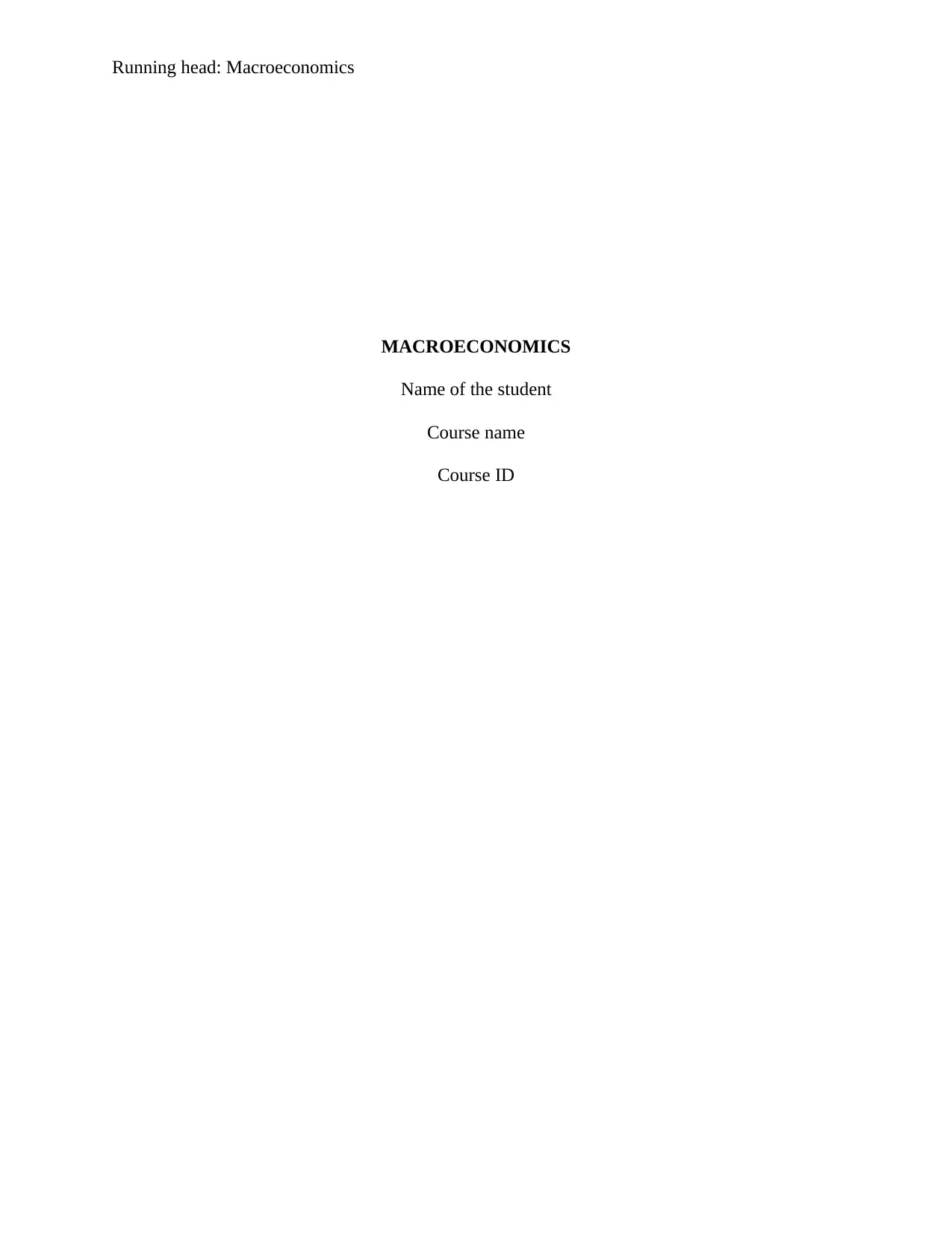
Running head: Macroeconomics
MACROECONOMICS
Name of the student
Course name
Course ID
MACROECONOMICS
Name of the student
Course name
Course ID
Paraphrase This Document
Need a fresh take? Get an instant paraphrase of this document with our AI Paraphraser

1
Macroeconomics
Table of Contents
Introduction......................................................................................................................................2
Part A: Economic performance indicators (EPI).............................................................................3
Growth in Real Gross Domestic Product.........................................................................................3
b. Public debt as a percentage of GDP............................................................................................4
c. Rate of inflation...........................................................................................................................5
d. Interest rates.................................................................................................................................6
e. Current account surplus/deficit as a percent of GDP...................................................................7
f. Exchange rate trends....................................................................................................................8
g. Unemployment rates....................................................................................................................9
1. An evaluation of how the 2007-2008 Global Financial Crises (GFC) affected the country’s
economy.........................................................................................................................................10
2. Assessment of the economic policies that has been implemented by government...................11
3. Description and evaluates changes in key economic performance indicators...........................12
4. Assessment of economic performances indicator......................................................................16
Conclusion.....................................................................................................................................17
Macroeconomics
Table of Contents
Introduction......................................................................................................................................2
Part A: Economic performance indicators (EPI).............................................................................3
Growth in Real Gross Domestic Product.........................................................................................3
b. Public debt as a percentage of GDP............................................................................................4
c. Rate of inflation...........................................................................................................................5
d. Interest rates.................................................................................................................................6
e. Current account surplus/deficit as a percent of GDP...................................................................7
f. Exchange rate trends....................................................................................................................8
g. Unemployment rates....................................................................................................................9
1. An evaluation of how the 2007-2008 Global Financial Crises (GFC) affected the country’s
economy.........................................................................................................................................10
2. Assessment of the economic policies that has been implemented by government...................11
3. Description and evaluates changes in key economic performance indicators...........................12
4. Assessment of economic performances indicator......................................................................16
Conclusion.....................................................................................................................................17
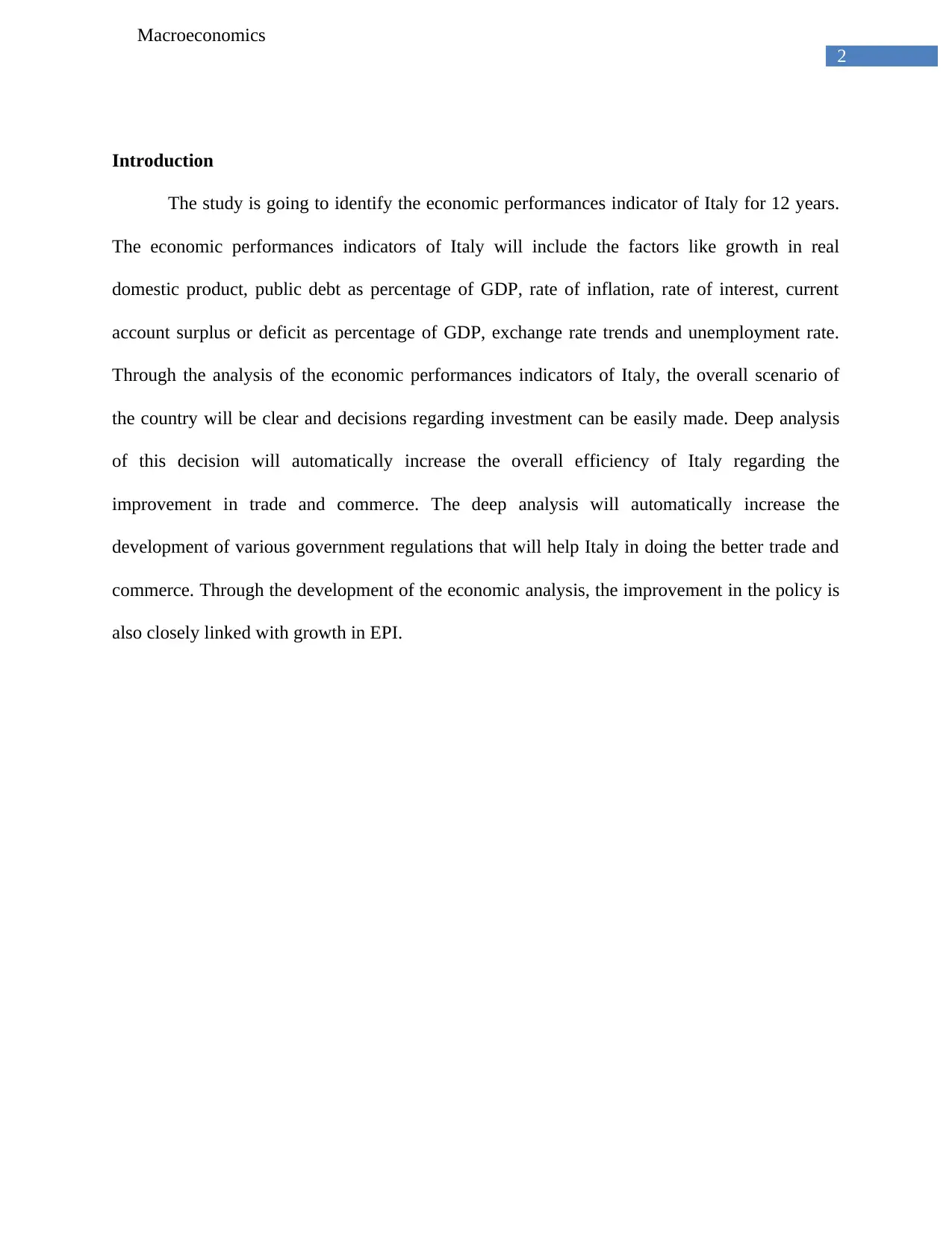
2
Macroeconomics
Introduction
The study is going to identify the economic performances indicator of Italy for 12 years.
The economic performances indicators of Italy will include the factors like growth in real
domestic product, public debt as percentage of GDP, rate of inflation, rate of interest, current
account surplus or deficit as percentage of GDP, exchange rate trends and unemployment rate.
Through the analysis of the economic performances indicators of Italy, the overall scenario of
the country will be clear and decisions regarding investment can be easily made. Deep analysis
of this decision will automatically increase the overall efficiency of Italy regarding the
improvement in trade and commerce. The deep analysis will automatically increase the
development of various government regulations that will help Italy in doing the better trade and
commerce. Through the development of the economic analysis, the improvement in the policy is
also closely linked with growth in EPI.
Macroeconomics
Introduction
The study is going to identify the economic performances indicator of Italy for 12 years.
The economic performances indicators of Italy will include the factors like growth in real
domestic product, public debt as percentage of GDP, rate of inflation, rate of interest, current
account surplus or deficit as percentage of GDP, exchange rate trends and unemployment rate.
Through the analysis of the economic performances indicators of Italy, the overall scenario of
the country will be clear and decisions regarding investment can be easily made. Deep analysis
of this decision will automatically increase the overall efficiency of Italy regarding the
improvement in trade and commerce. The deep analysis will automatically increase the
development of various government regulations that will help Italy in doing the better trade and
commerce. Through the development of the economic analysis, the improvement in the policy is
also closely linked with growth in EPI.
⊘ This is a preview!⊘
Do you want full access?
Subscribe today to unlock all pages.

Trusted by 1+ million students worldwide
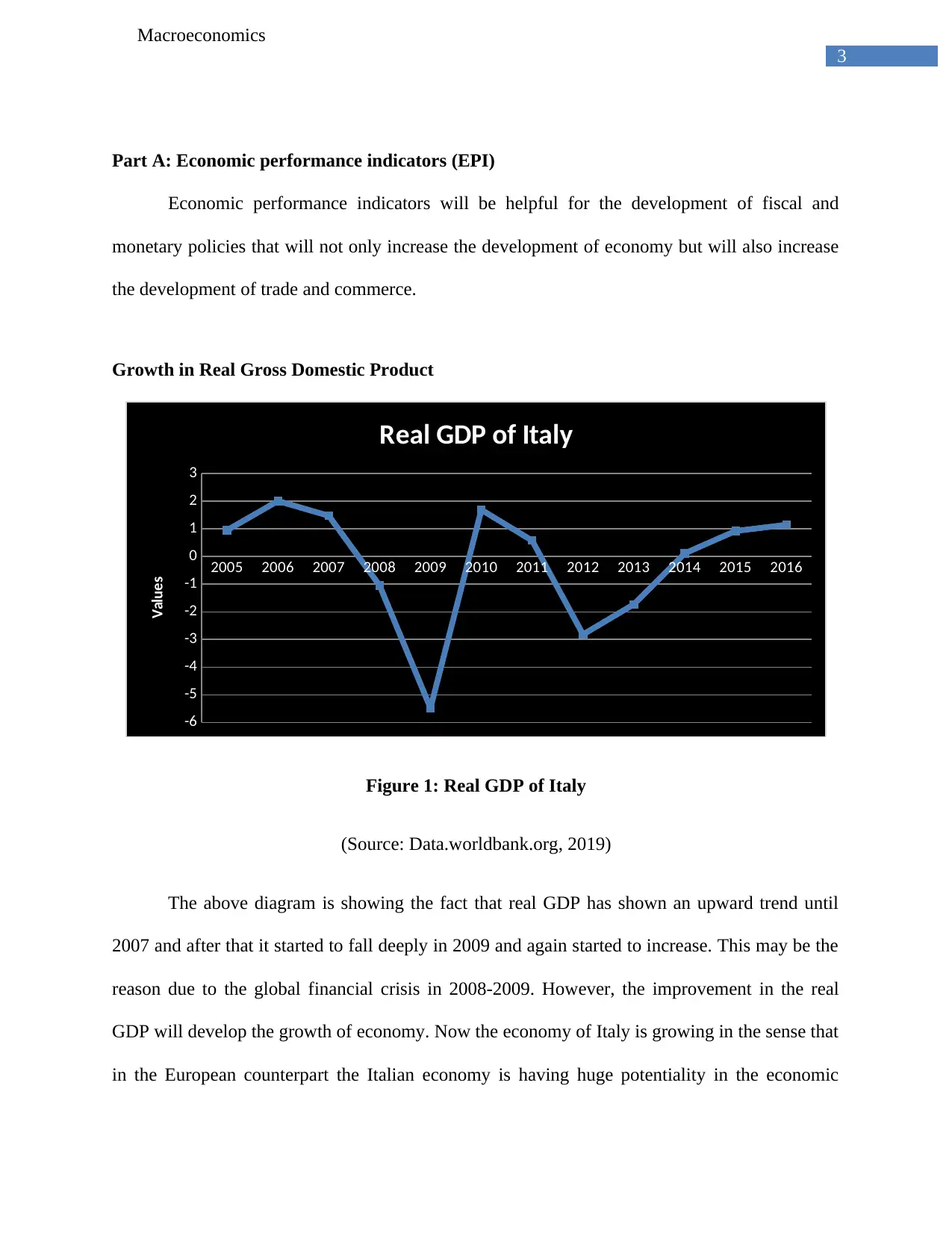
3
Macroeconomics
Part A: Economic performance indicators (EPI)
Economic performance indicators will be helpful for the development of fiscal and
monetary policies that will not only increase the development of economy but will also increase
the development of trade and commerce.
Growth in Real Gross Domestic Product
2005 2006 2007 2008 2009 2010 2011 2012 2013 2014 2015 2016
-6
-5
-4
-3
-2
-1
0
1
2
3
Real GDP of Italy
Values
Figure 1: Real GDP of Italy
(Source: Data.worldbank.org, 2019)
The above diagram is showing the fact that real GDP has shown an upward trend until
2007 and after that it started to fall deeply in 2009 and again started to increase. This may be the
reason due to the global financial crisis in 2008-2009. However, the improvement in the real
GDP will develop the growth of economy. Now the economy of Italy is growing in the sense that
in the European counterpart the Italian economy is having huge potentiality in the economic
Macroeconomics
Part A: Economic performance indicators (EPI)
Economic performance indicators will be helpful for the development of fiscal and
monetary policies that will not only increase the development of economy but will also increase
the development of trade and commerce.
Growth in Real Gross Domestic Product
2005 2006 2007 2008 2009 2010 2011 2012 2013 2014 2015 2016
-6
-5
-4
-3
-2
-1
0
1
2
3
Real GDP of Italy
Values
Figure 1: Real GDP of Italy
(Source: Data.worldbank.org, 2019)
The above diagram is showing the fact that real GDP has shown an upward trend until
2007 and after that it started to fall deeply in 2009 and again started to increase. This may be the
reason due to the global financial crisis in 2008-2009. However, the improvement in the real
GDP will develop the growth of economy. Now the economy of Italy is growing in the sense that
in the European counterpart the Italian economy is having huge potentiality in the economic
Paraphrase This Document
Need a fresh take? Get an instant paraphrase of this document with our AI Paraphraser
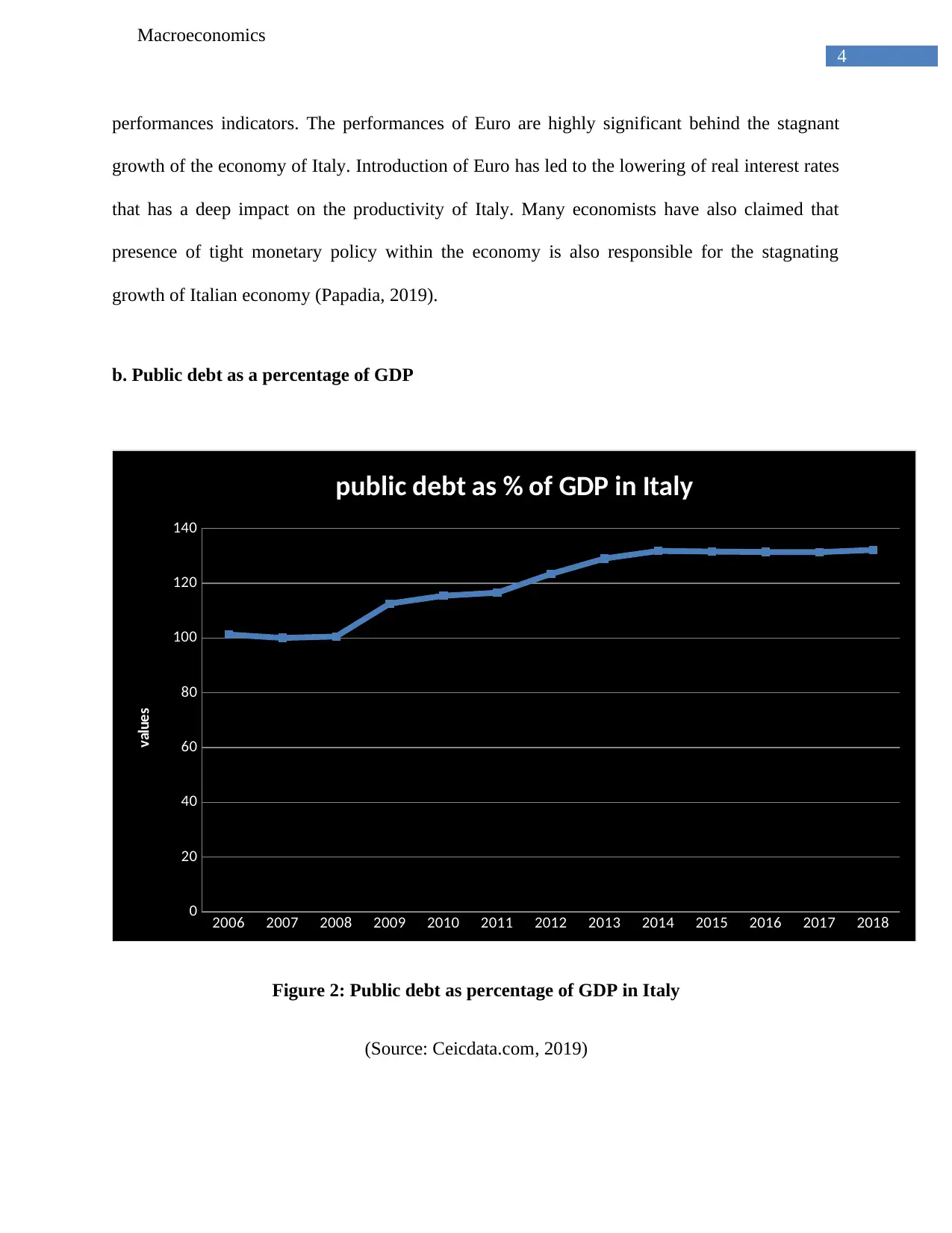
4
Macroeconomics
performances indicators. The performances of Euro are highly significant behind the stagnant
growth of the economy of Italy. Introduction of Euro has led to the lowering of real interest rates
that has a deep impact on the productivity of Italy. Many economists have also claimed that
presence of tight monetary policy within the economy is also responsible for the stagnating
growth of Italian economy (Papadia, 2019).
b. Public debt as a percentage of GDP
2006 2007 2008 2009 2010 2011 2012 2013 2014 2015 2016 2017 2018
0
20
40
60
80
100
120
140
public debt as % of GDP in Italy
values
Figure 2: Public debt as percentage of GDP in Italy
(Source: Ceicdata.com, 2019)
Macroeconomics
performances indicators. The performances of Euro are highly significant behind the stagnant
growth of the economy of Italy. Introduction of Euro has led to the lowering of real interest rates
that has a deep impact on the productivity of Italy. Many economists have also claimed that
presence of tight monetary policy within the economy is also responsible for the stagnating
growth of Italian economy (Papadia, 2019).
b. Public debt as a percentage of GDP
2006 2007 2008 2009 2010 2011 2012 2013 2014 2015 2016 2017 2018
0
20
40
60
80
100
120
140
public debt as % of GDP in Italy
values
Figure 2: Public debt as percentage of GDP in Italy
(Source: Ceicdata.com, 2019)
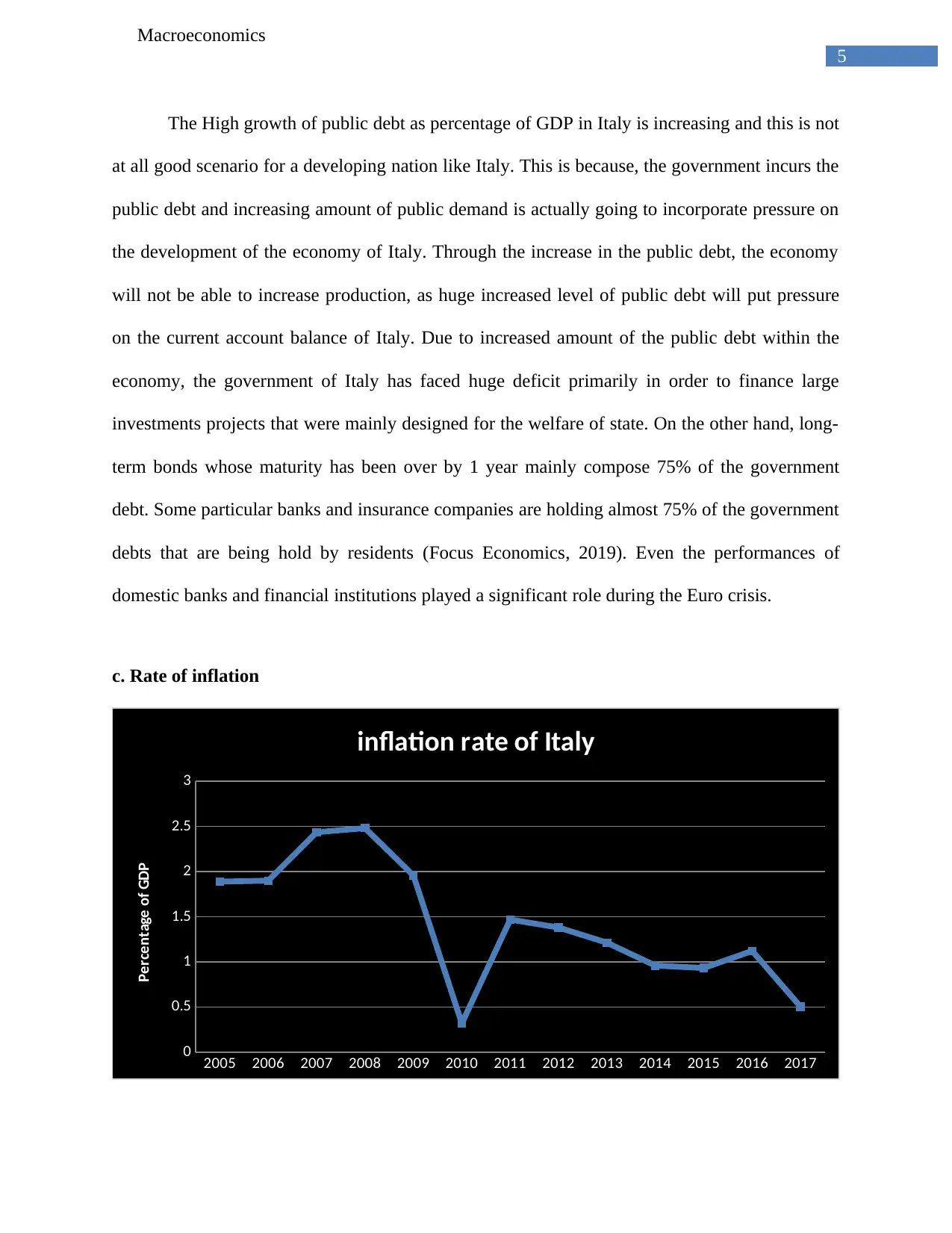
5
Macroeconomics
The High growth of public debt as percentage of GDP in Italy is increasing and this is not
at all good scenario for a developing nation like Italy. This is because, the government incurs the
public debt and increasing amount of public demand is actually going to incorporate pressure on
the development of the economy of Italy. Through the increase in the public debt, the economy
will not be able to increase production, as huge increased level of public debt will put pressure
on the current account balance of Italy. Due to increased amount of the public debt within the
economy, the government of Italy has faced huge deficit primarily in order to finance large
investments projects that were mainly designed for the welfare of state. On the other hand, long-
term bonds whose maturity has been over by 1 year mainly compose 75% of the government
debt. Some particular banks and insurance companies are holding almost 75% of the government
debts that are being hold by residents (Focus Economics, 2019). Even the performances of
domestic banks and financial institutions played a significant role during the Euro crisis.
c. Rate of inflation
2005 2006 2007 2008 2009 2010 2011 2012 2013 2014 2015 2016 2017
0
0.5
1
1.5
2
2.5
3
inflation rate of Italy
Percentage of GDP
Macroeconomics
The High growth of public debt as percentage of GDP in Italy is increasing and this is not
at all good scenario for a developing nation like Italy. This is because, the government incurs the
public debt and increasing amount of public demand is actually going to incorporate pressure on
the development of the economy of Italy. Through the increase in the public debt, the economy
will not be able to increase production, as huge increased level of public debt will put pressure
on the current account balance of Italy. Due to increased amount of the public debt within the
economy, the government of Italy has faced huge deficit primarily in order to finance large
investments projects that were mainly designed for the welfare of state. On the other hand, long-
term bonds whose maturity has been over by 1 year mainly compose 75% of the government
debt. Some particular banks and insurance companies are holding almost 75% of the government
debts that are being hold by residents (Focus Economics, 2019). Even the performances of
domestic banks and financial institutions played a significant role during the Euro crisis.
c. Rate of inflation
2005 2006 2007 2008 2009 2010 2011 2012 2013 2014 2015 2016 2017
0
0.5
1
1.5
2
2.5
3
inflation rate of Italy
Percentage of GDP
⊘ This is a preview!⊘
Do you want full access?
Subscribe today to unlock all pages.

Trusted by 1+ million students worldwide
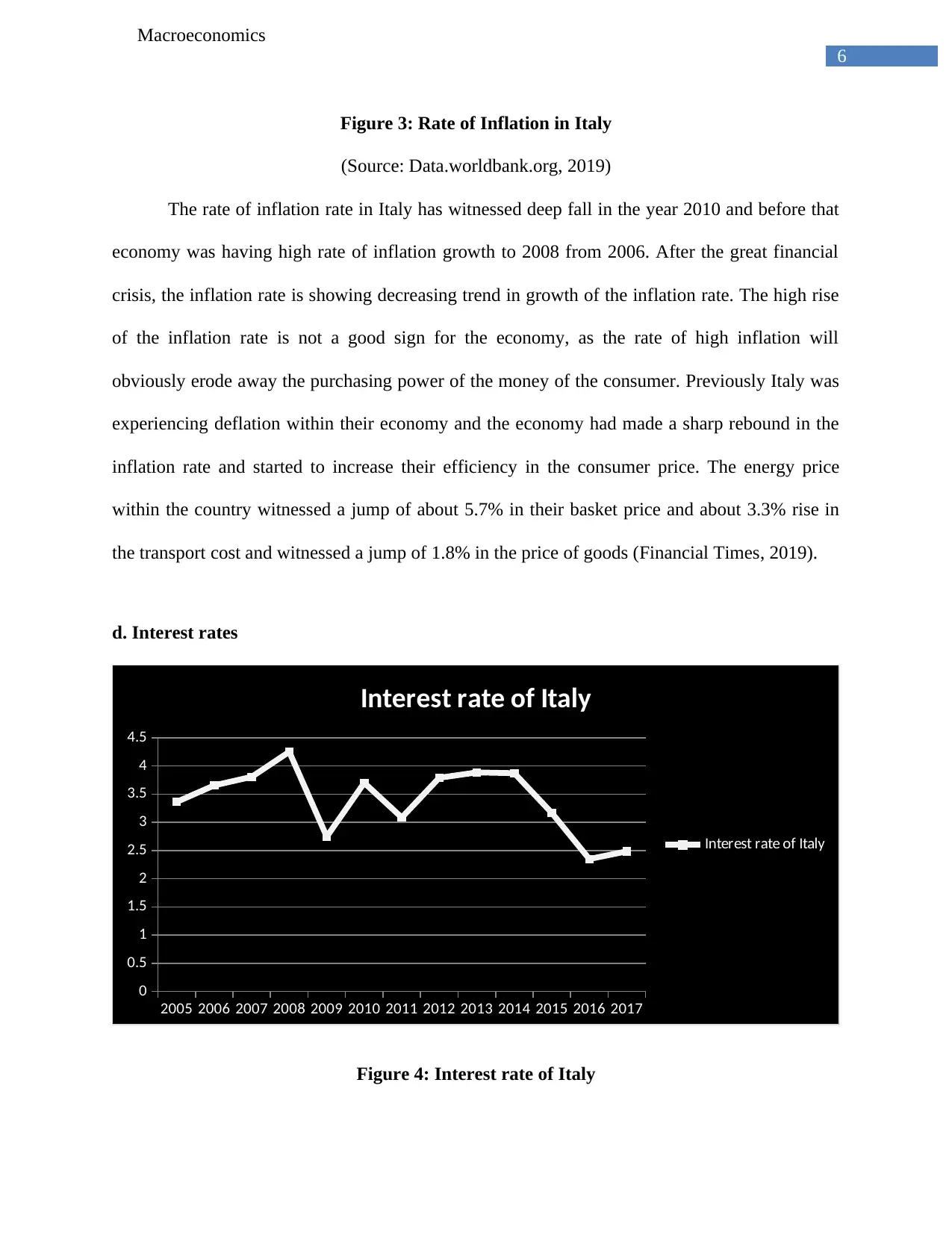
6
Macroeconomics
Figure 3: Rate of Inflation in Italy
(Source: Data.worldbank.org, 2019)
The rate of inflation rate in Italy has witnessed deep fall in the year 2010 and before that
economy was having high rate of inflation growth to 2008 from 2006. After the great financial
crisis, the inflation rate is showing decreasing trend in growth of the inflation rate. The high rise
of the inflation rate is not a good sign for the economy, as the rate of high inflation will
obviously erode away the purchasing power of the money of the consumer. Previously Italy was
experiencing deflation within their economy and the economy had made a sharp rebound in the
inflation rate and started to increase their efficiency in the consumer price. The energy price
within the country witnessed a jump of about 5.7% in their basket price and about 3.3% rise in
the transport cost and witnessed a jump of 1.8% in the price of goods (Financial Times, 2019).
d. Interest rates
2005 2006 2007 2008 2009 2010 2011 2012 2013 2014 2015 2016 2017
0
0.5
1
1.5
2
2.5
3
3.5
4
4.5
Interest rate of Italy
Interest rate of Italy
Figure 4: Interest rate of Italy
Macroeconomics
Figure 3: Rate of Inflation in Italy
(Source: Data.worldbank.org, 2019)
The rate of inflation rate in Italy has witnessed deep fall in the year 2010 and before that
economy was having high rate of inflation growth to 2008 from 2006. After the great financial
crisis, the inflation rate is showing decreasing trend in growth of the inflation rate. The high rise
of the inflation rate is not a good sign for the economy, as the rate of high inflation will
obviously erode away the purchasing power of the money of the consumer. Previously Italy was
experiencing deflation within their economy and the economy had made a sharp rebound in the
inflation rate and started to increase their efficiency in the consumer price. The energy price
within the country witnessed a jump of about 5.7% in their basket price and about 3.3% rise in
the transport cost and witnessed a jump of 1.8% in the price of goods (Financial Times, 2019).
d. Interest rates
2005 2006 2007 2008 2009 2010 2011 2012 2013 2014 2015 2016 2017
0
0.5
1
1.5
2
2.5
3
3.5
4
4.5
Interest rate of Italy
Interest rate of Italy
Figure 4: Interest rate of Italy
Paraphrase This Document
Need a fresh take? Get an instant paraphrase of this document with our AI Paraphraser
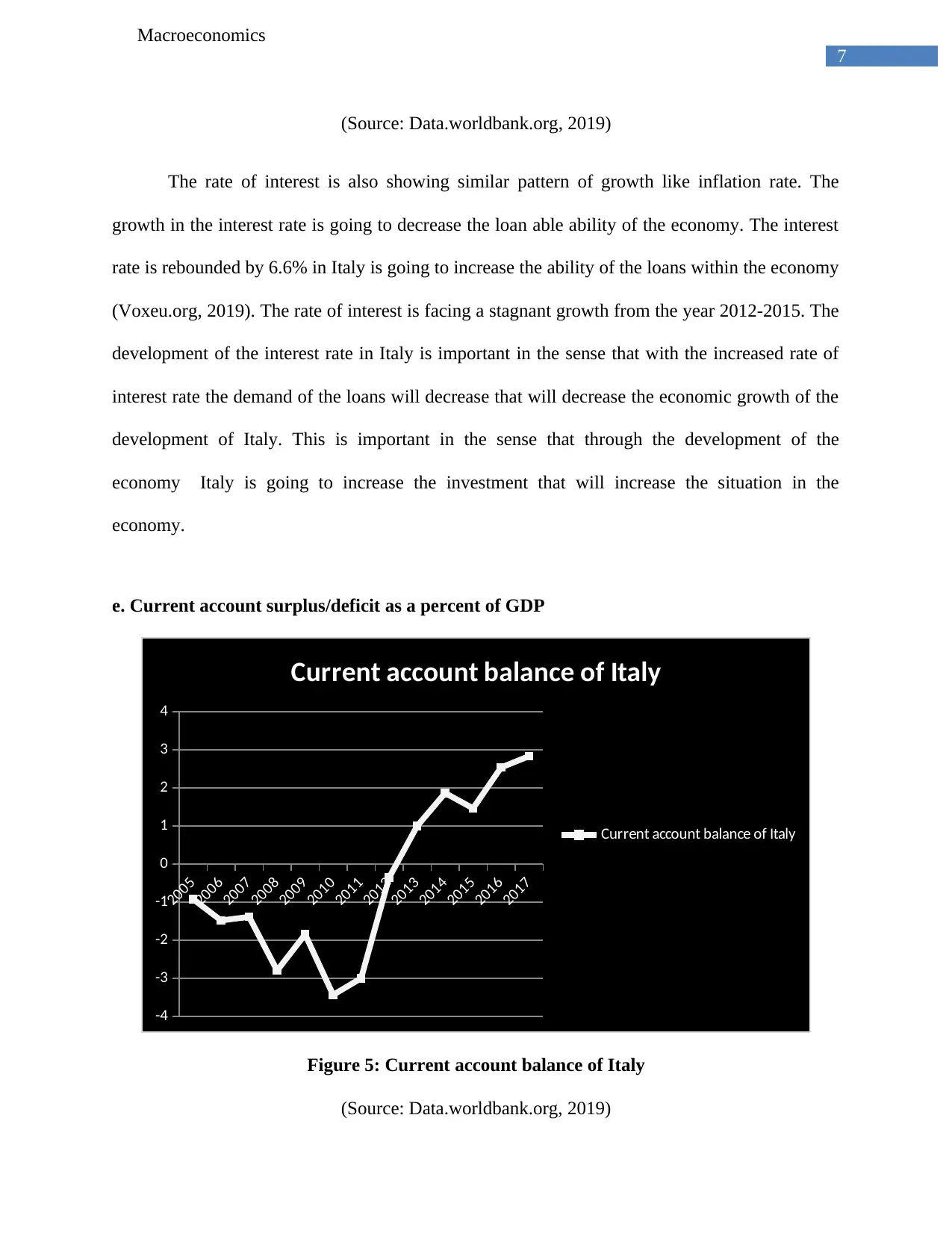
7
Macroeconomics
(Source: Data.worldbank.org, 2019)
The rate of interest is also showing similar pattern of growth like inflation rate. The
growth in the interest rate is going to decrease the loan able ability of the economy. The interest
rate is rebounded by 6.6% in Italy is going to increase the ability of the loans within the economy
(Voxeu.org, 2019). The rate of interest is facing a stagnant growth from the year 2012-2015. The
development of the interest rate in Italy is important in the sense that with the increased rate of
interest rate the demand of the loans will decrease that will decrease the economic growth of the
development of Italy. This is important in the sense that through the development of the
economy Italy is going to increase the investment that will increase the situation in the
economy.
e. Current account surplus/deficit as a percent of GDP
2005
2006
2007
2008
2009
2010
2011
2012
2013
2014
2015
2016
2017
-4
-3
-2
-1
0
1
2
3
4
Current account balance of Italy
Current account balance of Italy
Figure 5: Current account balance of Italy
(Source: Data.worldbank.org, 2019)
Macroeconomics
(Source: Data.worldbank.org, 2019)
The rate of interest is also showing similar pattern of growth like inflation rate. The
growth in the interest rate is going to decrease the loan able ability of the economy. The interest
rate is rebounded by 6.6% in Italy is going to increase the ability of the loans within the economy
(Voxeu.org, 2019). The rate of interest is facing a stagnant growth from the year 2012-2015. The
development of the interest rate in Italy is important in the sense that with the increased rate of
interest rate the demand of the loans will decrease that will decrease the economic growth of the
development of Italy. This is important in the sense that through the development of the
economy Italy is going to increase the investment that will increase the situation in the
economy.
e. Current account surplus/deficit as a percent of GDP
2005
2006
2007
2008
2009
2010
2011
2012
2013
2014
2015
2016
2017
-4
-3
-2
-1
0
1
2
3
4
Current account balance of Italy
Current account balance of Italy
Figure 5: Current account balance of Italy
(Source: Data.worldbank.org, 2019)
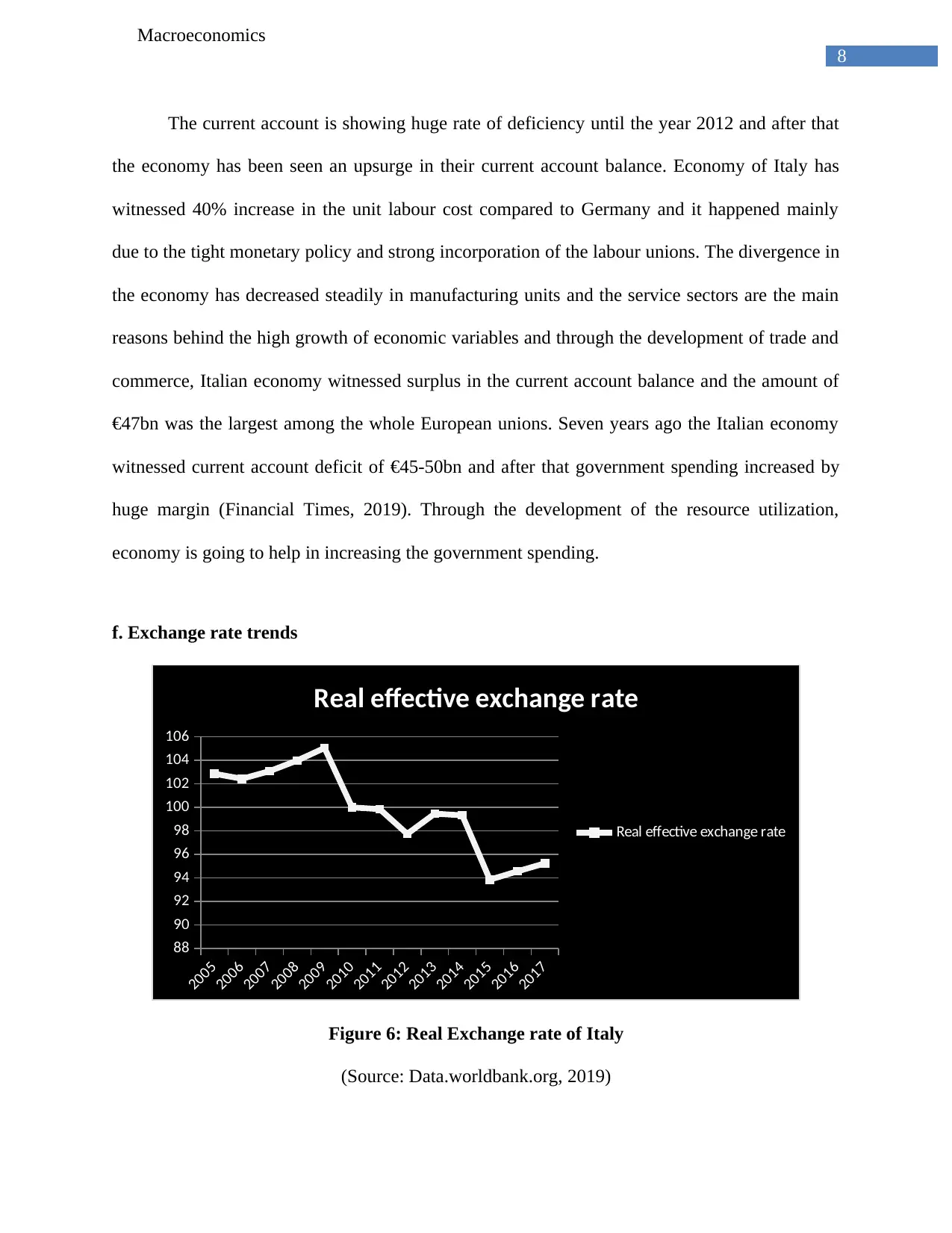
8
Macroeconomics
The current account is showing huge rate of deficiency until the year 2012 and after that
the economy has been seen an upsurge in their current account balance. Economy of Italy has
witnessed 40% increase in the unit labour cost compared to Germany and it happened mainly
due to the tight monetary policy and strong incorporation of the labour unions. The divergence in
the economy has decreased steadily in manufacturing units and the service sectors are the main
reasons behind the high growth of economic variables and through the development of trade and
commerce, Italian economy witnessed surplus in the current account balance and the amount of
€47bn was the largest among the whole European unions. Seven years ago the Italian economy
witnessed current account deficit of €45-50bn and after that government spending increased by
huge margin (Financial Times, 2019). Through the development of the resource utilization,
economy is going to help in increasing the government spending.
f. Exchange rate trends
2005
2006
2007
2008
2009
2010
2011
2012
2013
2014
2015
2016
2017
88
90
92
94
96
98
100
102
104
106
Real effective exchange rate
Real effective exchange rate
Figure 6: Real Exchange rate of Italy
(Source: Data.worldbank.org, 2019)
Macroeconomics
The current account is showing huge rate of deficiency until the year 2012 and after that
the economy has been seen an upsurge in their current account balance. Economy of Italy has
witnessed 40% increase in the unit labour cost compared to Germany and it happened mainly
due to the tight monetary policy and strong incorporation of the labour unions. The divergence in
the economy has decreased steadily in manufacturing units and the service sectors are the main
reasons behind the high growth of economic variables and through the development of trade and
commerce, Italian economy witnessed surplus in the current account balance and the amount of
€47bn was the largest among the whole European unions. Seven years ago the Italian economy
witnessed current account deficit of €45-50bn and after that government spending increased by
huge margin (Financial Times, 2019). Through the development of the resource utilization,
economy is going to help in increasing the government spending.
f. Exchange rate trends
2005
2006
2007
2008
2009
2010
2011
2012
2013
2014
2015
2016
2017
88
90
92
94
96
98
100
102
104
106
Real effective exchange rate
Real effective exchange rate
Figure 6: Real Exchange rate of Italy
(Source: Data.worldbank.org, 2019)
⊘ This is a preview!⊘
Do you want full access?
Subscribe today to unlock all pages.

Trusted by 1+ million students worldwide
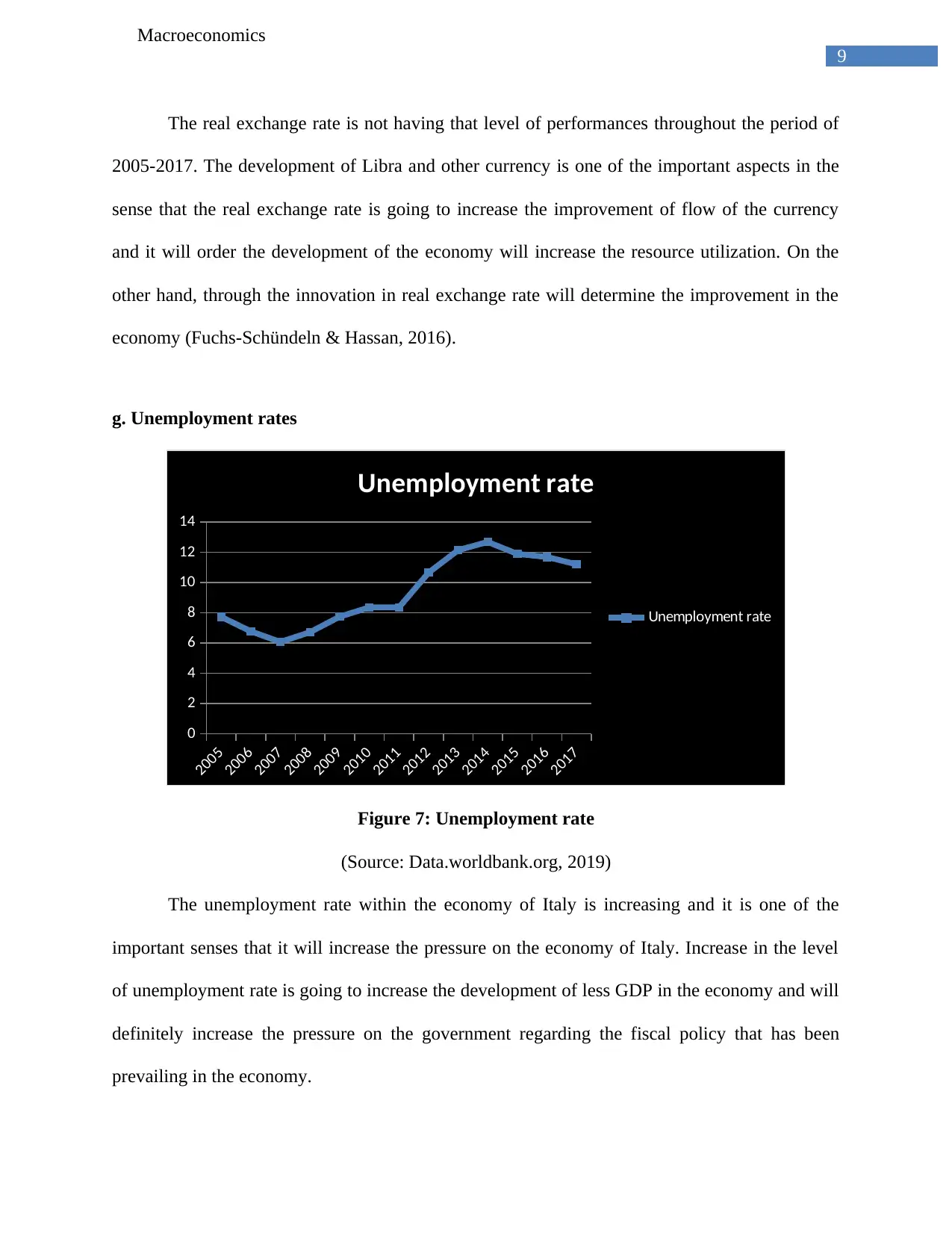
9
Macroeconomics
The real exchange rate is not having that level of performances throughout the period of
2005-2017. The development of Libra and other currency is one of the important aspects in the
sense that the real exchange rate is going to increase the improvement of flow of the currency
and it will order the development of the economy will increase the resource utilization. On the
other hand, through the innovation in real exchange rate will determine the improvement in the
economy (Fuchs-Schündeln & Hassan, 2016).
g. Unemployment rates
2005
2006
2007
2008
2009
2010
2011
2012
2013
2014
2015
2016
2017
0
2
4
6
8
10
12
14
Unemployment rate
Unemployment rate
Figure 7: Unemployment rate
(Source: Data.worldbank.org, 2019)
The unemployment rate within the economy of Italy is increasing and it is one of the
important senses that it will increase the pressure on the economy of Italy. Increase in the level
of unemployment rate is going to increase the development of less GDP in the economy and will
definitely increase the pressure on the government regarding the fiscal policy that has been
prevailing in the economy.
Macroeconomics
The real exchange rate is not having that level of performances throughout the period of
2005-2017. The development of Libra and other currency is one of the important aspects in the
sense that the real exchange rate is going to increase the improvement of flow of the currency
and it will order the development of the economy will increase the resource utilization. On the
other hand, through the innovation in real exchange rate will determine the improvement in the
economy (Fuchs-Schündeln & Hassan, 2016).
g. Unemployment rates
2005
2006
2007
2008
2009
2010
2011
2012
2013
2014
2015
2016
2017
0
2
4
6
8
10
12
14
Unemployment rate
Unemployment rate
Figure 7: Unemployment rate
(Source: Data.worldbank.org, 2019)
The unemployment rate within the economy of Italy is increasing and it is one of the
important senses that it will increase the pressure on the economy of Italy. Increase in the level
of unemployment rate is going to increase the development of less GDP in the economy and will
definitely increase the pressure on the government regarding the fiscal policy that has been
prevailing in the economy.
Paraphrase This Document
Need a fresh take? Get an instant paraphrase of this document with our AI Paraphraser
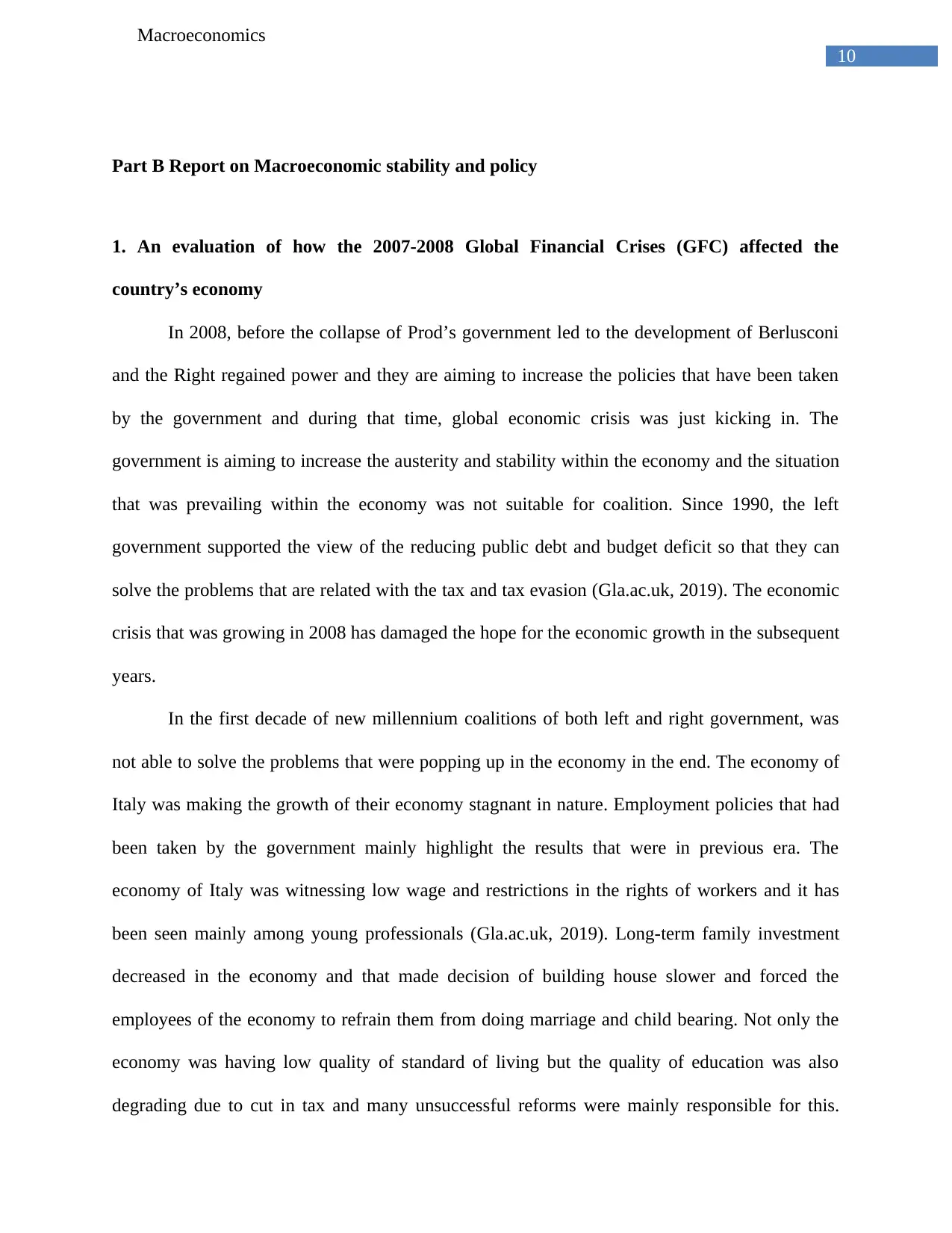
10
Macroeconomics
Part B Report on Macroeconomic stability and policy
1. An evaluation of how the 2007-2008 Global Financial Crises (GFC) affected the
country’s economy
In 2008, before the collapse of Prod’s government led to the development of Berlusconi
and the Right regained power and they are aiming to increase the policies that have been taken
by the government and during that time, global economic crisis was just kicking in. The
government is aiming to increase the austerity and stability within the economy and the situation
that was prevailing within the economy was not suitable for coalition. Since 1990, the left
government supported the view of the reducing public debt and budget deficit so that they can
solve the problems that are related with the tax and tax evasion (Gla.ac.uk, 2019). The economic
crisis that was growing in 2008 has damaged the hope for the economic growth in the subsequent
years.
In the first decade of new millennium coalitions of both left and right government, was
not able to solve the problems that were popping up in the economy in the end. The economy of
Italy was making the growth of their economy stagnant in nature. Employment policies that had
been taken by the government mainly highlight the results that were in previous era. The
economy of Italy was witnessing low wage and restrictions in the rights of workers and it has
been seen mainly among young professionals (Gla.ac.uk, 2019). Long-term family investment
decreased in the economy and that made decision of building house slower and forced the
employees of the economy to refrain them from doing marriage and child bearing. Not only the
economy was having low quality of standard of living but the quality of education was also
degrading due to cut in tax and many unsuccessful reforms were mainly responsible for this.
Macroeconomics
Part B Report on Macroeconomic stability and policy
1. An evaluation of how the 2007-2008 Global Financial Crises (GFC) affected the
country’s economy
In 2008, before the collapse of Prod’s government led to the development of Berlusconi
and the Right regained power and they are aiming to increase the policies that have been taken
by the government and during that time, global economic crisis was just kicking in. The
government is aiming to increase the austerity and stability within the economy and the situation
that was prevailing within the economy was not suitable for coalition. Since 1990, the left
government supported the view of the reducing public debt and budget deficit so that they can
solve the problems that are related with the tax and tax evasion (Gla.ac.uk, 2019). The economic
crisis that was growing in 2008 has damaged the hope for the economic growth in the subsequent
years.
In the first decade of new millennium coalitions of both left and right government, was
not able to solve the problems that were popping up in the economy in the end. The economy of
Italy was making the growth of their economy stagnant in nature. Employment policies that had
been taken by the government mainly highlight the results that were in previous era. The
economy of Italy was witnessing low wage and restrictions in the rights of workers and it has
been seen mainly among young professionals (Gla.ac.uk, 2019). Long-term family investment
decreased in the economy and that made decision of building house slower and forced the
employees of the economy to refrain them from doing marriage and child bearing. Not only the
economy was having low quality of standard of living but the quality of education was also
degrading due to cut in tax and many unsuccessful reforms were mainly responsible for this.
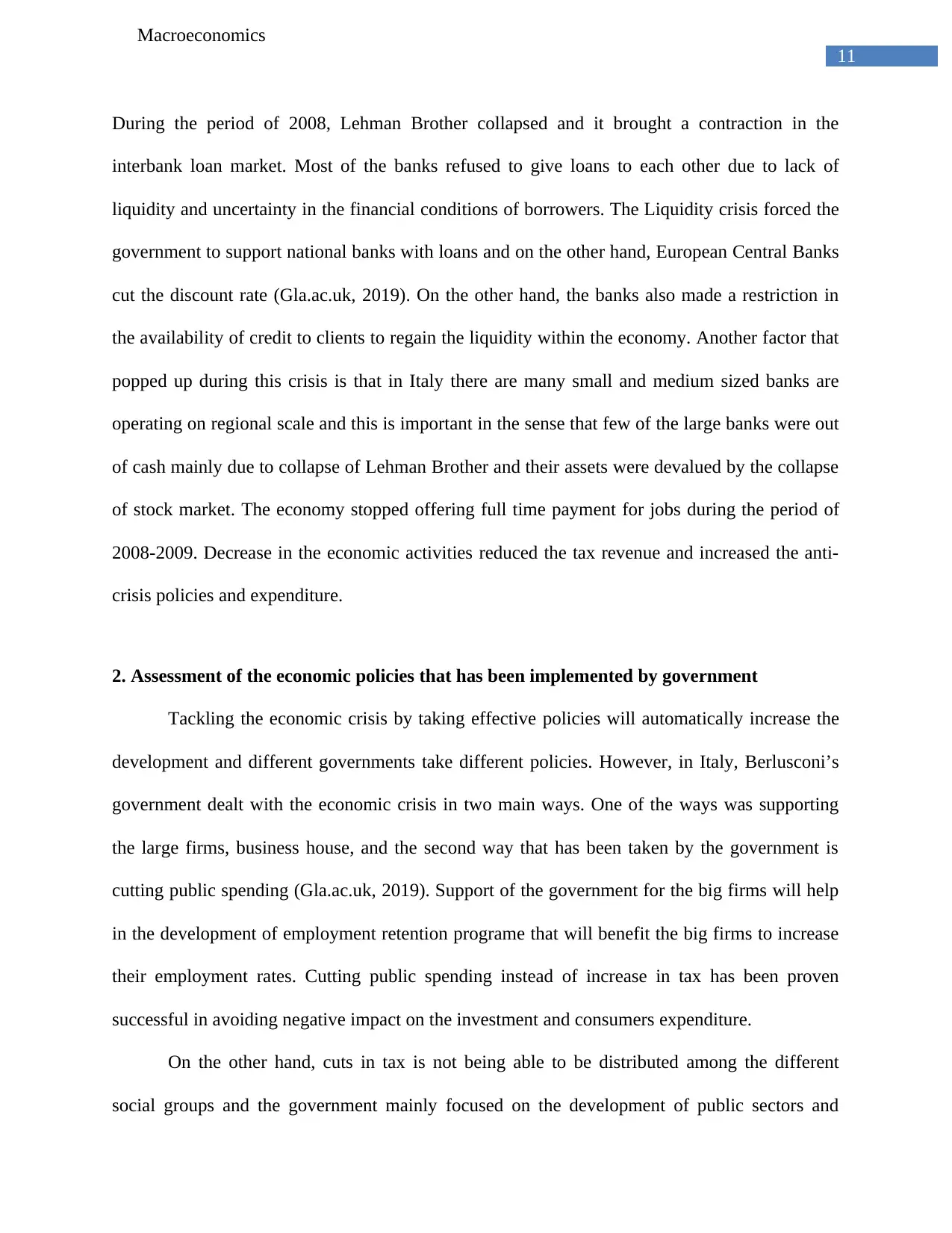
11
Macroeconomics
During the period of 2008, Lehman Brother collapsed and it brought a contraction in the
interbank loan market. Most of the banks refused to give loans to each other due to lack of
liquidity and uncertainty in the financial conditions of borrowers. The Liquidity crisis forced the
government to support national banks with loans and on the other hand, European Central Banks
cut the discount rate (Gla.ac.uk, 2019). On the other hand, the banks also made a restriction in
the availability of credit to clients to regain the liquidity within the economy. Another factor that
popped up during this crisis is that in Italy there are many small and medium sized banks are
operating on regional scale and this is important in the sense that few of the large banks were out
of cash mainly due to collapse of Lehman Brother and their assets were devalued by the collapse
of stock market. The economy stopped offering full time payment for jobs during the period of
2008-2009. Decrease in the economic activities reduced the tax revenue and increased the anti-
crisis policies and expenditure.
2. Assessment of the economic policies that has been implemented by government
Tackling the economic crisis by taking effective policies will automatically increase the
development and different governments take different policies. However, in Italy, Berlusconi’s
government dealt with the economic crisis in two main ways. One of the ways was supporting
the large firms, business house, and the second way that has been taken by the government is
cutting public spending (Gla.ac.uk, 2019). Support of the government for the big firms will help
in the development of employment retention programe that will benefit the big firms to increase
their employment rates. Cutting public spending instead of increase in tax has been proven
successful in avoiding negative impact on the investment and consumers expenditure.
On the other hand, cuts in tax is not being able to be distributed among the different
social groups and the government mainly focused on the development of public sectors and
Macroeconomics
During the period of 2008, Lehman Brother collapsed and it brought a contraction in the
interbank loan market. Most of the banks refused to give loans to each other due to lack of
liquidity and uncertainty in the financial conditions of borrowers. The Liquidity crisis forced the
government to support national banks with loans and on the other hand, European Central Banks
cut the discount rate (Gla.ac.uk, 2019). On the other hand, the banks also made a restriction in
the availability of credit to clients to regain the liquidity within the economy. Another factor that
popped up during this crisis is that in Italy there are many small and medium sized banks are
operating on regional scale and this is important in the sense that few of the large banks were out
of cash mainly due to collapse of Lehman Brother and their assets were devalued by the collapse
of stock market. The economy stopped offering full time payment for jobs during the period of
2008-2009. Decrease in the economic activities reduced the tax revenue and increased the anti-
crisis policies and expenditure.
2. Assessment of the economic policies that has been implemented by government
Tackling the economic crisis by taking effective policies will automatically increase the
development and different governments take different policies. However, in Italy, Berlusconi’s
government dealt with the economic crisis in two main ways. One of the ways was supporting
the large firms, business house, and the second way that has been taken by the government is
cutting public spending (Gla.ac.uk, 2019). Support of the government for the big firms will help
in the development of employment retention programe that will benefit the big firms to increase
their employment rates. Cutting public spending instead of increase in tax has been proven
successful in avoiding negative impact on the investment and consumers expenditure.
On the other hand, cuts in tax is not being able to be distributed among the different
social groups and the government mainly focused on the development of public sectors and
⊘ This is a preview!⊘
Do you want full access?
Subscribe today to unlock all pages.

Trusted by 1+ million students worldwide
1 out of 21
Related Documents
Your All-in-One AI-Powered Toolkit for Academic Success.
+13062052269
info@desklib.com
Available 24*7 on WhatsApp / Email
![[object Object]](/_next/static/media/star-bottom.7253800d.svg)
Unlock your academic potential
Copyright © 2020–2025 A2Z Services. All Rights Reserved. Developed and managed by ZUCOL.





